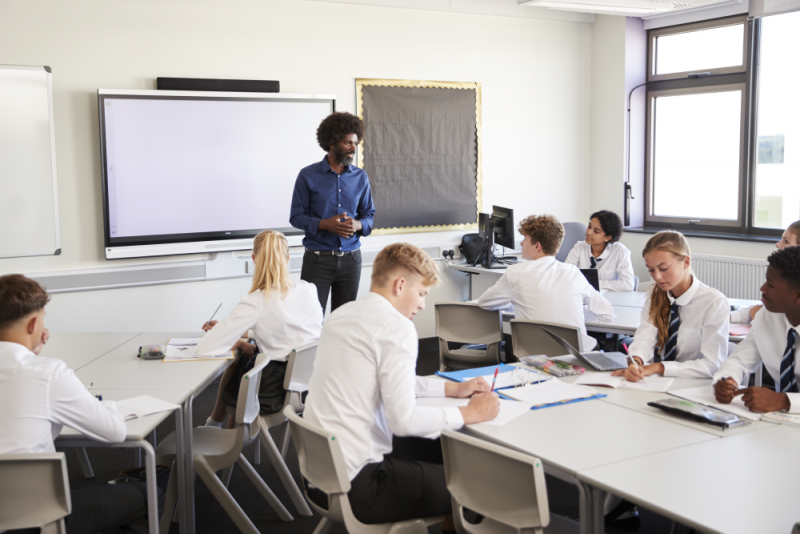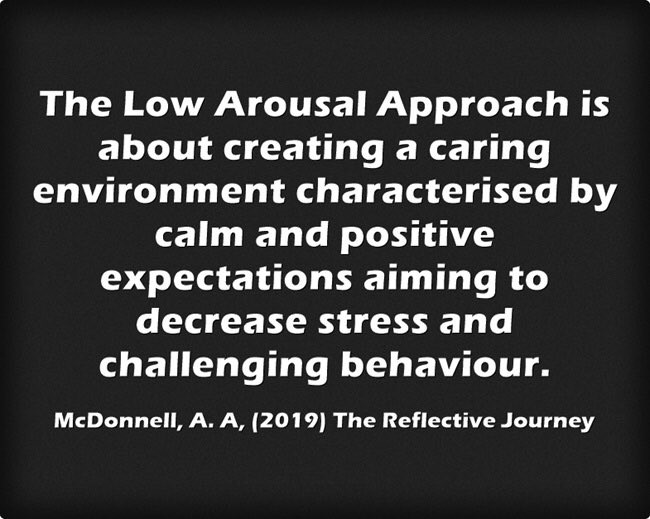Gareth D Morewood explores how to embed Low Arousal approaches in classrooms, schools and settings, so that all young people can thrive.

Previously I wrote about the importance of constant consistency with regard to whole-school approaches. For me this is one of the most important elements of a school’s ‘ethos’ and ‘culture’, very closely accompanied by the core business of any educational setting: learning and teaching.
In this post I want to draw on ideas from Low Arousal approaches regarding learning and teaching and demonstrate how that, along with a consistent culture as a whole-school approach, it is possible to apply this methodology in schools and improve outcomes for young people.
The Low Arousal Approach emphasises a range of strategies that focus on the reduction of stress, fear and frustration. These strategies are put in place to prevent dysregulation and avoid crisis situations. The low arousal approach seeks to understand the role of the ‘situation’ by identifying triggers and using low intensity solutions to avoid reactive consequences for individuals with additional needs.
This approach has been proven to enable practitioners to defuse crisis situations within a variety of settings through early identification and intervention. Applying this proactive (rather than reactive) approach to learning and educational environments seems eminently sensible to me! And one that I have considerable experience implementing during my career, with very positive outcomes for young people.
In the development and application of these approaches, there is a strong emphasis on ‘in the moment’ actions and decision-making and being a reflective practitioner. There’s a quote I often use when talking to practitioners and families which sums things up pretty well: nobody fights when they are feeling relaxed and easy-going.
Calm and self-control are connected. In applying the Low Arousal approach to teaching and learning it is all about the culture within the classroom; founded on a good understanding of stress and consistent proactive approaches. Maintaining a calm, consistent learning environment, applying what the evidence would suggest is a good investment in learning, creates a purposeful environment that allows everyone the opportunity to thrive.
Creating a calm, consistent, positive learning environment benefits everyone – a good strategy for young people with additional needs, rarely, if ever, harms or hinders peers
Physiological arousal can be strongly linked to the construct of stress (McDonnell et al, 2014) and arousal and stress are considered to be important in the regulation of emotion (Reich & Zautra, 2002). In a dysregulated classroom, where stress can be significant, arousal states of everyone (staff and young people) will be high.
This doesn’t need to be the case, and I have worked with many colleagues who naturally establish such positive cultures for learning. For those of us for whom this doesn’t come naturally, I am certain that we can develop and create our own low arousal environments.

Whilst these approaches have often only been considered for young people and adults with complex histories, additional needs and experience of trauma, I believe that these key aims and philosophies are coterminous with good educational pedagogy.
Creating a calm, consistent, positive learning environment benefits everyone – a good strategy for young people with additional needs, rarely, if ever, harms or hinders peers.
I have been very fortunate to have the opportunity to develop these ideas in conjunction with the Saturation Model as part of the new LASER Programme. The ideas centre around looking at how we set up whole-school systems and structures coupled with consistent, calm approaches to learning drawing on what the evidence suggests is a good investment. The core principals are about:
A strong pillar throughout is co-production – working jointly on identifying challenges and finding solutions to improve the outcomes for young people.
I’ve written quite extensively about co-production in the past. Rather than repeat myself here, I’ve highlighted relevant reading for further investigation.
An integrated family approach, encompassing education, health and other services, is most effective in preparing children for adulthood.
Co-production requires a relocation of power into the hands of families and young people.
We need to manage our own stress to prevent this from affecting those who are unable to differentiate.
After a quarter of a century working in schools, I am certain of one thing – positive and effective joint working and collaboration is the most effective way of improving outcomes for young people.
Some of the key elements of this approach, from research and personal experience, are listed below.
For me, the vital thing about this way of working is the ability to truly personalise responses to the individual setting/establishment. This happens through:
Personalisation isn’t just about individuals; it’s about communities as well.
Positive examples regarding classroom routines and structure are numerous, but from my experience creating that calm and consistent learning environment starts with knowing your students and how to arrange and set-up the classroom for optimal learning.
For example:
All of these feed into the low arousal classroom. Many of these ideas are not new or ground-breaking, but simply a combination of what I believe works best, based on my personal experience and what I’ve seen in support settings around the globe.
I have spoken about changing the culture in schools and settings many times over the last few years. Embedding sustainable change takes time; whilst some short-term gains can be made with blanket policies and reactive approaches, my personal philosophy is very much about embedding long-term structures and cultures that stand the test of time.
This is hard work and the opposite of an ‘off-the-shelf’ school improvement package written away from the specific context of the individual setting.
Sustainable culture change must be personalised to the community and setting; just understanding that is an important first step in creating and sustaining positive change.
As with any culture/ethos change, ongoing support and coaching is the most effective way to ensure consistency and collaboration.
Too often I’ve seen a singular input on a training day or session with the expectation that everyone can implement things equally as a result. Adaptations may need to be made to systems before change can occur, and some colleagues will need further support.
Joint working and shared experiences can be so important, particularly during these challenging times. To that end, there is much that can be adapted and implemented at no (or very low) cost – something which has always been part of my mantra of ‘high impact – low cost’ support and training.
We’ve very much kept all of this in mind when designing the LASER programme. It’s all about supporting a personalised approach to learning, drawing on a range of systems and strategies, and forging an approach that’s suited to your community, setting and people.
In the next blog post I will explore further what the research suggests is a good investment in learning and what inclusive pedagogy means to me, within the context of the structures outlined above.